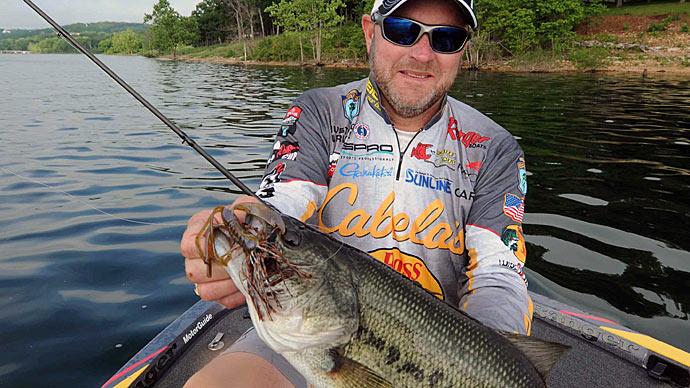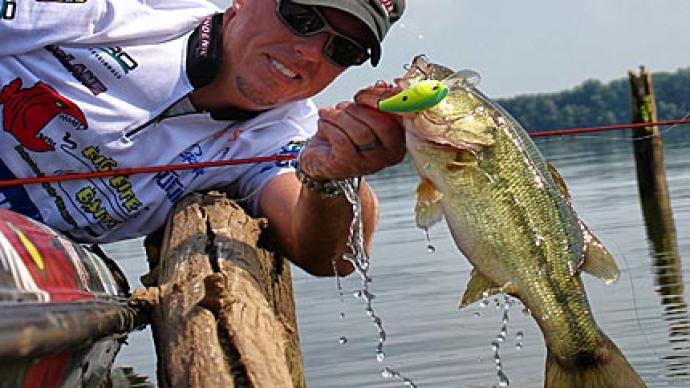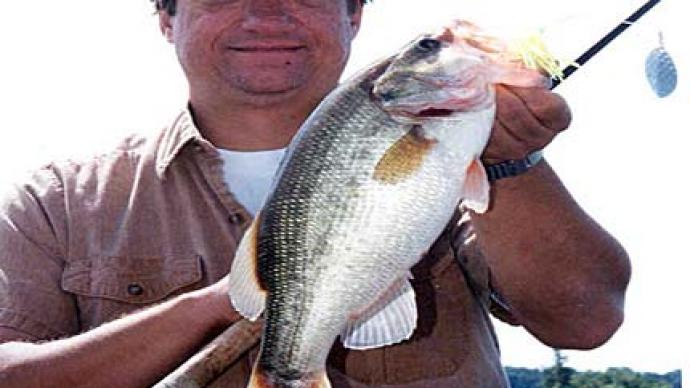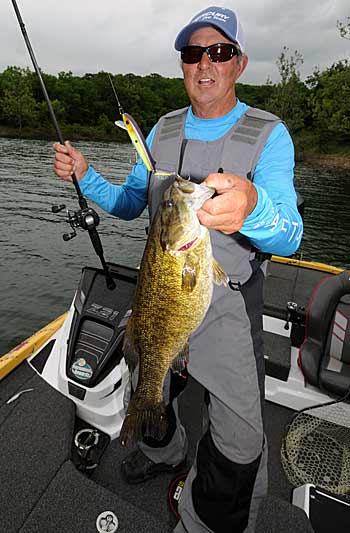
The lure seductively wiggles as it wakes across the surface.
Suddenly the water explodes, and the lure disappears.
This scenario plays out frequently when postspawn bass look for an easy meal. Topwater fishing becomes one of the most effective tactics for catching bass recuperating from the spawn.
“It takes a lot of those fish a couple of weeks to rest up, and before they go to their summertime homes, they just suspend and rest up a little bit,” Table Rock Lake guide Pete Wenners says. “The reason the (topwater) bite is so good because the fish are resting up, and the shad are also getting ready to spawn.”
The Missouri guide notes that the postspawn stage for bass usually starts when the water temperature climbs to around 65 to 68 degrees and the shad begin spawning around 70 degrees. “Bass usually won’t go very far from where they spawn,” Wenners says. “Once they rest up and feed back up, and the water gets warmer, they start moving out to their summertime habitat. “
Wenners suggests postspawn bass will use the same migration route the fish used during the prespawn and can be caught on topwater lures along the way. “The first good topwater bite will start just outside and even in the spawning areas, then they will start moving out to deeper docks and deeper water in the coves and migrate out to the points before they get out on a lot of the deep water structure,” Wenners says.
Postspawn stages determine which topwater lure Wenners chooses. He notices immediately following the spawn when bass are guarding fry, the fish seem to prefer subtle lures, so he opts for a Zoom Fluke or Strike King Caffeine Shad he can work on the surface.
The Missouri angler rigs the soft jerkbaits with a 5/0 hook and throws it on spinning tackle with 12- or 14-pound Sunline fluorocarbon. He employs a twitch, twitch, pause retrieve to keep the lure near the surface and will let the lure fall out of sight if conditions are calm and the water is clear. His favorite Fluke colors are watermelon, Mardi Gras, pro blue, and smokin’ shad.
Later in the postspawn, when the water continues to warm, and bass become more aggressive, Wenners switches to jointed or straight-bodied wake baits. Throughout the years, Wenners has used a variety of wake baits, such as the Cotton Cordell Red Fin that needed to be tweaked to make the lures stay on top better, but now he favors the Cotton Cordell Jointed Red Fin Wakebait.
Reeling slowly is the key to retrieving the wake bait on the surface. “The biggest mistake everybody makes with the wake baits is if you can’t see the bait on the surface or if it’s not making a pretty little wake, you are fishing it too fast,” Wenners says. He suggests keeping your rod tip up for most of the retrieve to help prevent it from diving. You can drop your rod tip once the lure runs closer to the boat.
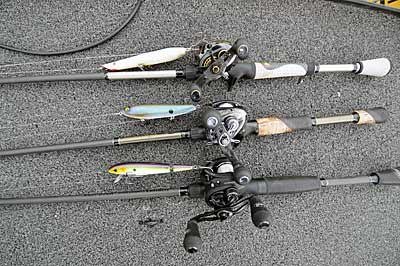
Wenners ties his wake baits on 14-pound test Sunline Super Natural Monofilament and uses a high-speed baitcast reel (7.5:1 gear ratio) for all of his topwater plugs. His favorite waking bait colors include Kentucky blue, Table Rock (purple/chartreuse), and chrome.
By the middle to late postspawn, Wenners chooses walking baits such as the Heddon Zara Spook, Strike King Sexy Dawg, and the Spro Fat Papa Walker for aggressive bass. He also favors the walking baits when the water surface becomes too choppy for bass to hone in on wake baits.
Wenners works the walking baits in the standard walk-the-dog retrieve on 30-pound braid. He favors braid because he makes long casts with the walking baits, and braid has less stretch than monofilament, which gives him a better hookset when a bass hits the lure at the far end of his cast. Bone and the same hues Wenners selects for wake baits are also productive colors for the walking plugs.
If the surface has too much chop or if Wenners believes he is fishing an area with big bass potential, he will choose a bigger topwater such as a Cotton Cordell Pencil Popper for postspawn bass. “The Pencil Popper is a pretty versatile bait because you can walk it like a cigar-type lure, or you can work it like a big Pop R,” Wenners says.
The Table Rock guide experiments with the retrieve alternating between walking and popping the Pencil Popper to see which method triggers the most strikes. The same colors he selects for his walking plugs are also his favorite hues for the Pencil Popper.
Quick hooksets can lead to missed fish when postspawn bass strike at any of the topwater plugs. “Many of these postspawn fish early on will just come up and suck the lure down,” Wenners says. “The problem is when you are watching it, and you see the fish hit it, your first reaction is to jerk. It is the hardest thing not to do, but you almost have to wait until you feel the fish.” He suggests when you feel the fish on your line, start reeling and slowly sweep the rod to set the hook.
Waiting to set the hook will also give you another chance to catch a bass that took a swipe at and missed your topwater plug. “Whatever you were doing before the fish hit, just keep doing that and keep it moving,” Wenners says. “If you set the hook right away, you might pull the lure 3 to 5 feet away from them, and it is no longer in the strike zone.” In many instances, the fish will hit the lure again when you restart your retrieve.
BassResource may receive a portion of revenues if you make a purchase using a link above.

